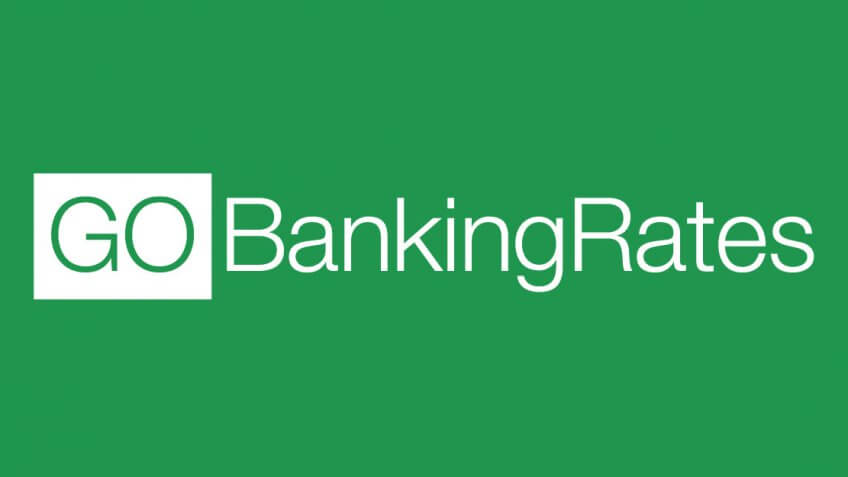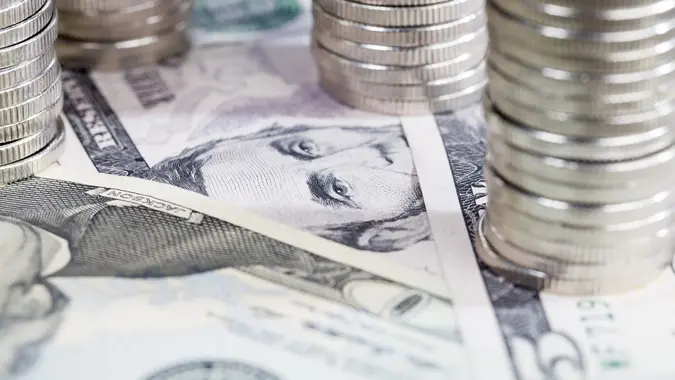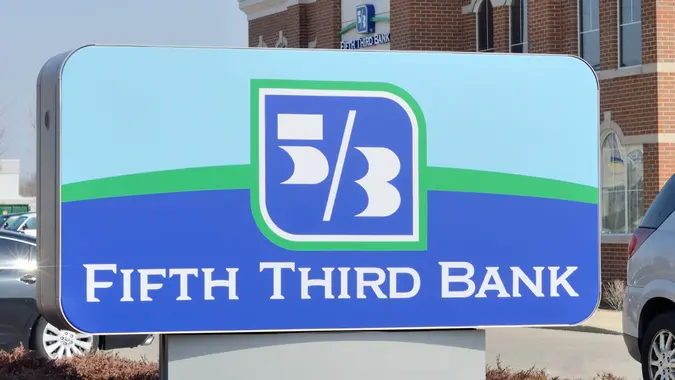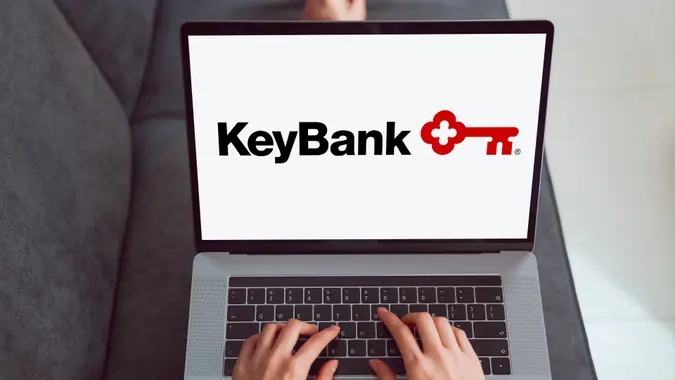How Much Does a $10,000 CD Make in a Year?

Commitment to Our Readers
GOBankingRates' editorial team is committed to bringing you unbiased reviews and information. We use data-driven methodologies to evaluate financial products and services - our reviews and ratings are not influenced by advertisers. You can read more about our editorial guidelines and our products and services review methodology.

20 Years
Helping You Live Richer

Reviewed
by Experts

Trusted by
Millions of Readers
A certificate of deposit typically offers higher interest rates than money market or savings accounts. CDs — or certificates, as credit unions call them — are popular investment options to lock in a high yield for a specific time frame.
For people saving for a house, a new car, or an event like a wedding or a vacation, a CD delivers stable savings with reduced temptation to tap into the money before the CD term ends.
If you invest $10,000 in a one-year CD with a 4.00% APY — a healthy return today, compounded monthly, you’d have $10,407.42 after 12 months.
How To Calculate CD Earnings
You can use an online compound interest calculator to find out how much your CD will earn. You can also calculate it yourself using this formula: A = P(1 + r/n)^(nt).
In this formula:
- P equals the principal or your initial investment
- r equals the rate of return
- n equals the compounding frequency
- t equals the CD’s term, or how long your money stays in the account at that interest rate.
Examples of CD Earnings for $10,000 in a Year
If you deposit $10,000 in a one-year CD, where interest is compounded annually, you’d have $10,100 at the end of the term. A = $10,000(1 + 1%/1)^(1×1).
A one-year CD with an APY of 2.50% would deliver $250 in earnings, giving you $10,250 by the end of the term. A CD with a higher APY of 5.00% would give you $10,500 at the end of the 12-month term.
Factors that Influence CD Earnings
CD earnings can vary greatly based on a few factors.
The average interest rates for CDs change over time. That’s why it’s good to lock in a longer-term CD when interest rates are high or if the U.S. Federal Reserve is predicting a rate cut. Financial institutions set CD interest rates, in part, on the prime rate set by the U.S. Federal Reserve. Banks and credit unions who want to compete for your savings against larger banks may offer higher rates. Online financial institutions typically offer higher interest rates since they have lower overhead than brick-and-mortar banks.
Interest rates also vary depending on the CD term, which is the length of time you must keep that money in the CD without early withdrawal penalties. Banks sometimes offer higher “promotional rates” on one-year CDs. In general, the longer the term, the higher the interest rate, although that’s not always true.
Finally, the compound frequency will affect your earnings. When money compounds, you earn interest on your initial deposit plus any interest earned. A CD that compounds monthly will earn more over time than a CD that compounds annually. For instance, a one-year, 5.00% APY CD that compounds monthly will give you $10,511.62 after one year, while a CD that compounds annually will only deliver $10,500.
Where To Find the Best Rates for a $10,000 CD
You can find the best rates for a CD by shopping around, the same way you would for a high-yield savings account. When shopping for a CD, first decide on the term. If you are saving for an event or major purchase, you’ll want to lock in a CD with a term that coincides with your event. Then, compare rates at online banks, credit unions, and traditional banks to find the highest yield.
The best CD rates today can yield an APY as high as 5.00%. You’ll find this rate on an 18-month CD at Mountain America Credit Union. If you’re looking for a shorter term, consider Brilliant Bank’s 3-month CD at or a 6-month CD from CommunityWide Federal Credit Union, with an APY of
Pros and Cons of Investing $10,000 in a CD
CDs provide an effective savings vehicle for long or short-term goals. They provide predictable, guaranteed returns. Unlike stock market investments, your deposits in a CD are safe; they are federally insured up to $250,000 by the FDIC; credit union certificates are similarly insured by the NCUA.
However, there are also some drawbacks. CDs have limited liquidity. That means if you need to withdraw your money before the term ends, you’ll face early withdrawal penalties and may sacrifice some of your interest earnings. If interest rates have a chance of rising, you might lock your money into a CD and lose opportunities for greater returns. Depending on inflation rates and your interest rate, your CD holdings may not grow to exceed the pace of inflation.
If you want more flexibility to withdraw or transfer funds as needed, consider a high-yield savings or money market account instead of a CD.
How To Choose the Right CD For Your $10,000 Investment
If you have $10,000 to invest, you’ll want to lock in a rate to maximize your earnings. Compare rates at different banks and credit unions. Understand how often interest compounds. You’re leaving money on the table with a CD that compounds annually compared to one that compounds monthly if the interest rates are the same.
Before you deposit funds, make sure you understand the minimum deposit requirements and early withdrawal penalties.
Tax Implications of CD Investments
The IRS taxes interest earned on CDs and sends a 1099-INT form indicating the interest earned. You’ll have to pay taxes on that interest even if your CD hasn’t reached its term. Be sure to account for this in tax planning, since you may not be able to tap into the funds earned by the CD to pay the taxes without paying penalties.
Good To Know
If you are saving for a house, wedding, vacation or a new car, opening a $10,000 CD is a great way to set money aside. Your money will earn interest at a higher rate than you might earn with a traditional savings account.
Additionally, you won’t be tempted to withdraw funds from the account because you might face penalties and fees. When you are ready to make your purchase, you can close out the CD when the term ends and easily access the money you need.
Final Note
With CD rates exceeding most other savings options, it’s a great time to invest some of your short-term or even longer-term savings into a high-yield CD. CDs offer high interest rates, no monthly fees and guaranteed returns. They’re an easy way to earn money without risk.
CD Rate FAQ
Here are the answers to some of the most frequently asked questions regarding interest rates and CD accounts.- What's the average interest rate for a 1-year CD?
- As of February 2025, the average interest rate for a 1-year CD is 1.80%, according to the latest update from the FDIC.
- Can I earn more by choosing a longer-term CD?
- Longer-term CDs sometimes have higher interest rates. As a trade-off for keeping your money locked in longer, you might earn a higher return. However, that's not always the case. You may be able to snag a high APY on a 12-month or 18-month CD, or even a shorter term with a special promotional rate. However, if interest rates on two CDs are equal, you'll earn more by keeping your money in a longer-term CD so it can accrue interest longer.
- What happens if I withdraw my CD early?
- If you need to withdraw funds from your CD early, you will pay early withdrawal penalties and will sacrifice the additional interest you would have accrued. Withdrawal penalties are typically equal to a portion of the interest you would have earned, ranging from three months to a full year of interest.
- Are online banks better for CD rates?
- Online banks have less overhead than traditional banks, which often means they can provide higher interest rates for CDs. However, you may find high-yield CDs at a local bank or credit union, too.
- How often do CD rates change?
- The interest rate on a CD remains locked in for the term of the CD. Banks change interest rates on new CDs frequently, so if you find a rate that meets your financial goals, it's smart to invest right away.
Rates are subject to change; unless otherwise noted, rates are updated periodically. All other information on accounts is accurate as of Feb. 26, 2025.
Virginia Anderson contributed to the reporting for this article.
Our in-house research team and on-site financial experts work together to create content that’s accurate, impartial, and up to date. We fact-check every single statistic, quote and fact using trusted primary resources to make sure the information we provide is correct. You can learn more about GOBankingRates’ processes and standards in our editorial policy.
- Federal Reserve Bank of St. Louis. " National Deposit Rates: 12-Month CD."
- Federal Reserve Bank of St. Louis. " National Deposit Rates: 60-Month CD."
 Written by
Written by  Edited by
Edited by 

























